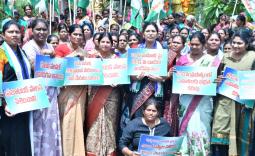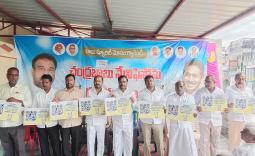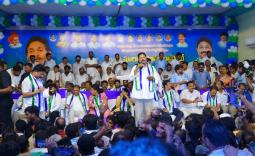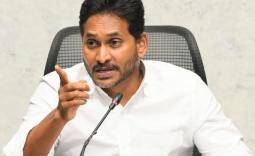YSRCP submits proposals to 14th Finance Commisison
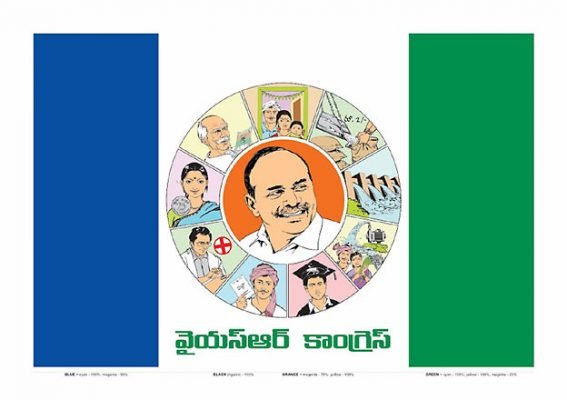
On Sept 13, 2013, YSR Congress party has submitted proposals to the 14th Finance Commission which visited Hyderabad. The following the full text of the proposals submitted to it by the party senior leaders DA Somayajulu and Ummareddy Venkateswarlu.
Memorandum
to Fourteenth Finance Commission
Hon’ble Chairman
and Hon’ble Members of Fourteenth Finance Commission.
We sincerely thank you for the opportunity given to us to make our
submissions on the subject of devolution of Central taxes to States. This
mainly covers two issues viz,
(1)
What andHow much of the Central Revenues should be
distributed among States? and
(2)
What weightage
should be assigned for various factors for apportionment of the divisible
Central revenues among various states?
Before discussing the above issues, I would like to express serious
concern at the way the Central Government is virtually messing up country’s
finances and as to how the country is being dragged into an irretrievable debt
trap and unprecedented foreign exchange crisis. Even in 1991 when India faced
its biggest foreign exchange crisis, it had a Current Account Deficit of only
2.6% of GDP. As against that, today India has more than 4.5% CAD. It is
reported that the short term debt burden with one year maturity has reached
about 25% of the total external debt, substantially pushing up the country’s short
term debt repayment obligation, further jeopardizing the already worsened
foreign exchange position of the country.
The fiscal deficit has been upwards of 5% of GDP in each of the last
four years and about 80% of this is going for meeting the revenue deficit. Because
the Central Government has been recklessly borrowing money not for stepping up
public expenditure and plan expenditure but for funding its ever mounting
revenue deficit, the RBI strangely has been starving the corporate sector of its
due share of funds. With the result, the corporate sector, which is the main
vehicle of India’s economic growth, is only seen in a casino called
stock exchanges where so much depends on the throw of the dice and not
on the fundamentals of Indian economy. The Union Finance Ministry in its July
2013 monthly report said
‘Overall growth in the Index of Industrial
Production (IIP) was (-) 2.2 per cent during June 2013 as compared to (-) 2.0
per cent in June 2012. During April- June 2013-14, IIP growth was (-) 1.1 per
cent as compared to (-) 0.2 per cent in April- June 2012-13. Eight core
Infrastructure industries registered 0.1 per cent growth in June 2013 as
compared to growth of 7.9 per cent in June 2012. During April- June 2013-14,
these sectors grew by 1.6 per cent as compared to 6.9 per cent during
April-June 2012-13.’
The same Report brought out that the Revenue Receipts of the Central
Government for the first quarter of the
current fiscal was (-) 1.3% over that of the corresponding figure of the previous
year, which was 30.6% over its previous year. At this rate, where is the
country going? What a sad state of affairs!
I have never known Indian economy being in such dire straits. There is
no coal, no gas and no electricity in the country with about 60% of SME sector
units virtually closing their shops. The prices of essential commodities are
going up. The saddest thing is that at
the end of the first quarter, as a proportion of budget estimate, the actual fiscal
deficit and revenue deficit during April–June 2013 were 48.4% and 55.4%
respectively, as against what should be 25%. This means India’s revenue
and fiscal deficit are going to go through the roof, further fuelling
inflation. In the last fiscal itself, the interest on borrowings accounted for
more than 30% of the Central Revenues. Given the current performance, there
will be no surprise if interest on loans will go upto 50% of Central Revenues.
Citing external factors as responsible for the present mess up is completely
incorrect as India with its $ 300 billion exports and $ 500 billion imports has
one of the lowest exposures in international trade. Despite this, the Central
Government goes on announcing one CSS or the other having huge revenue impact.
They want to penalise all the states even for minor violations of the FRBM act,
while they themselves have been behaving most irresponsibly. One of the
important items of TOR for the Fourteenth Finance Commission is about the
central revenues also.
Given the present situation, how will the 14th Finance
Commission go about its task in distributing Central revenues, which started
registering negative growth rate? Yet, the show must go on. Hence, the
following submission!
I.
What and How much of the Central Revenues should be distributed among
States?
Various Political Parties and various State Governments have
represented to the Thirteenth Finance
Commission that the cesses and surcharges along with the non-taxable revenues
of Central Government also shall become part of the divisible Central revenues,
which presently include only Customs Duty, Excise Duty, Service Tax and Direct
Taxes. It was also submitted that the indicative ceiling on all revenue account
transfers be fixed at 50 per cent of the Centre’s gross revenue receipts. The Thirteenth
Finance Commission, however, did not accede to the request of the States for
inclusion of cesses and non tax revenues for division among the States. They recommended
rising of this indicative ceiling to only 39.5 per cent of the Centre’s gross
revenue receipts. Further, the thirteenth Finance Commission recommended that
the share of states in net proceeds of shareable central taxes shall be 32 per
cent in each of the financial years from 2010-11 to 2014-15, as against the
demand of 40% by majority States of the country. The main reasons why the
Central Government should agree for much higher levels of devolution compared
to the 32% that they recommended are given below.
(1)
Prior to 1991,
Central Public Sector played a very crucial role in building Indian economy,
especially for employment and revenue generation and for removal of regional
disparities. The Central Government in keeping with its commitment for Regional
Balanced Development of the entire country, used to ensure that proportionate
industrial investment has been made in all the States in the country. Besides,
using the industrial licensing mechanism, Government used to ensure that there
was reasonable dispersal of industrial units in all regions of the country. For
instance, in our own state, many large Public Sector Units like BHEL, HMT, HAL,
IDPL, HCL, ECIL, BHPV, MIDHANI, BDL, Vizag Steel Project, Ordnance Factory,
NFC, BEL and many more such projects were set up by the Central Government and
these projects together with their ancillaries have provided employment to
lakhs of work force in the Sate, in addition to generating substantial revenues
to the State Government. During the
first 3 decades, many prestigious R & D laboratories like CCMB, DRDL, DLRL,
DMRL, NIN, NRSA, NGRI, IICT, Sriharikota Satellite Launching Pad and ICRISAT
were set up in AP and this has positively helped AP to emerge as one of the
important knowledge Hubs in the Country. All these initiatives have enabled the
local entrepreneurship to blossom, so much so that today AP is the largest
producer of bulk drugs and cement in the country. With the Government of India
opting out of further investments in Public Sector and with the removal of
licensing system for industrial promotion, it has essentially become the
responsibility of the State Governments to develop world class infrastructure
for attracting industrial investments, which requires substantial additional
investments by the state governments compared to the pre-1991 era. It should
also be implied that there are more surplus funds in the hands of Central
Government; now that they have stopped investing in Public Sector and by
implication those funds should be transferred to the state governments for
creation of infrastructure. The 14th Finance Commission should
therefore come out with a methodology to make greater allocations to the states
that have been embarking upon creation of good infrastructure facilities and
setting up of institutions like SEZs. Additional devolution should also be made
to state governments that are setting up exclusive institutions for upgrading
the skills and productivity levels of our labour.
(2)
India is such a
huge country that some of the States are bigger than many countries in the
world both in terms of area and population. Each State in India has its own
varying levels of development and prosperity among various districts, varying
levels of Human Development Index, varying resources and therefore each State
should be allowed to develop its own socio economic strategy consistent with
its resources and priorities. Unfortunately, every year the Union Government
has been adding one centrally sponsored scheme (CSS) or the other. For
instance, the NREG Program which is intended to provide a minimum of 100 days
employment in the years of drought to rural population is implemented across
the country even in years of excess rainfall. Besides, this scheme will be of
little relevance to States in the Indo-Gangetic plain as they do not depend so
much on the rains in their own states for their Agriculture. As against that,
the situation is completely different in respect of States that are located in
south of Vindhyas, where even the river system is rain dependent. We have seen
in our own State as to how for about 5 out of last 15 years the important
rivers virtually ran dry. So, it is inexplicable as to how the Central
Government is implementing such schemes uniformly all over the country?
Similarly, the Central Government has been implementing RKVY for incentivising
States that will meet the targets of achieving average annual growth rate of 4%
besides enhancing the food grains production of the country by 20 million
tonnes in a five years period. This whole scheme has become counterproductive
because of the formula that was adapted to incentivise States, as this has
nothing to do with the outcomes. States that maintained a particular level of
budgetary allocations for Agriculture and allied activates in proportion to
their plan expenditure were given this incentive, irrespective of whether they
really achieved the targets set out in the National Food Security Mission. We
really wonder as to how the Central Government can fix a uniform basis for the
whole country, particularly in respect to Agriculture, which is completely location
specific. For example, Andhra Pradesh itself has identified 322 farming
situations, each of which requires a different strategy and different levels of
investments. Already many States in the country have their own poverty
alleviation programs based on the local requirements. Some States like Andhra
Pradesh, thanks to the commitment of Late Dr. Y S Rajasekhara Reddy, have
implemented a plethora of welfare measures offering food security, old age
security, health security, housing and access to education at Government cost
on a saturation mode even while remaining FRBM compliant, without any Revenue
Deficit and without increasing rates of
VAT, municipal taxes, water charges, RTC charges and Power charges to
any class of consumers over a full five years period 2004-09. It is submitted
that the States are better placed to understand the needs of the people and
have the required capacity to prioritise expenditure within the framework of
FRBM act.
In the light of
this, the Union Government may kindly consider dispensing with a large number
of CSS programs and instead make higher revenue devolution to the States and
allow them to make their own choices for spending money on the welfare of the
people and development programs. It is strongly urged that the Fourteenth
Finance Commission should consider adding cesses and surcharges and non-taxable
revenues of Central Government to the present divisible taxes and of that
atleast at 40% should be shared by the Union Government with states.
II.
What weightage
should be assigned for various factors for apportionment of the divisible
Central Taxes among various states?
The Thirteenth Finance Commission has recommended the following
weights for devolution of Central Taxes among various States of the Country.
Table 8.1: Criteria and Weights for Tax
Devolution (per cent)
Criteria Weight
1. Population (1971) 25.0
2. Area 10.0
3. Fiscal Capacity Distance 47.5
4. Fiscal Discipline 17
The Thirteenth Finance Commission has
given highest weightage of 47.5% for Fiscal capacity distance. According to the
report, “the Fiscal distance is obtained
for each state by the distance of its estimated per capita revenue, from the
estimated per capita revenue of Haryana, the second highest in the per capita
income ranking after Goa. The distance so computed for all states, barring
Haryana and Goa, defines the per capita revenue entitlement of each state based
on fiscal distance. For Haryana and Goa, a revenue entitlement of Rs. 100 per
capita has been assigned. For Maharashtra, with average per capita GSDP
slightly lower than that of Haryana, the fiscal distance computed based on the
procedure described in the earlier paragraph worked out to be negative. We have
assigned it a notional revenue entitlement of Rs. 100 per capita, at par with
Haryana and Goa. These per capita entitlements are then multiplied by the
respective 1971 population figures of each state to arrive at the share of each
state in tax devolution. We have assigned a weight of 47.5 per cent to the
fiscal capacity distance criterion. The use of average tax-to-GSDP ratios
specific to each category neutralizes to an extent the fiscal disadvantage of
special category states in terms of tax capacity. Finally, another principle
governing devolution has to be cost disability, so that the amounts devolved
conform to equity-based fiscal need, modified by differing costs of service
delivery. Cost disability affects both general and special category states.” The intent is to estimate per capita
fiscal capacity at reasonably comparable levels of taxation by application of
the observed group average.
This, in our opinion, is not the best way of devolution of funds. Performing
States with higher revenues to GSDP ratio and higher Per Capita GDP or Per
Capita Net State Domestic Product will be punished and States which continue to
remain backward because of mis-governance will continue to get incentivized,
which the country should not encourage. The important consideration should be
the Human Development Index of each of the 600 odd districts in the country. Per
Capita estimates by themselves do not reflect the correct position of a
particular State. Within each State there are large variations of Per Capita
income, Human Development Index and other parameters. Just because Andhra
Pradesh has a very high Per Capita tax revenue, it does not automatically
ensure better Human Development for all the people living in different
districts in the State. For instance, the GSDP of Maharashtra is Rs. 13.72 lakh
crores for the year 2012-13 and naturally it has the highest per capita income
among big states in the country. The finance commission considers that all the
35 districts of Maharashtra are equally developed and have the same Rs.
1,05,000 per capita income. Unfortunately this is not true. Nine of their 35
districts in Maharashtra, not only have per capita incomes lower than that of
the State average but also lower than the Country’s average of Rs. 61,656 for
the year 2011-12. 17 districts in all have lower per capita income than the
State average. These districts are as bad as those in Orissa or Bihar or other
places. Same is the case with Andhra Pradesh, which had per capita income of
Rs.60703 for year 2010-11 as against national average of Rs. 54151. 9 out of 23
districts of Andhra Pradesh have per capita incomes lower than that of national
average and of the balance 14, ten districts clearly have much lower per capita
income than the State average. Maharashtra does not mean just Mumbai and Pune
cities, where only 15-20% of the State’s population lives; it includes all
those living in semi urban and rural areas. For example, as per latest RBI
statistics, whereas the total bank lending in Maharashtra as on 31-12-2012 was
Rs. 14.36 lakh crores, the urban centers accounted for a lending if Rs. 13.67
lakh crores, while the balance 75% of people in the State are availing of a bank
credit of Rs. 69,000 crores. Similarly for Andhra Pradesh, as against the total
bank lending of Rs. 4.10 lakh crores as on 31-12-2012, about Rs. 3 lakh crores
is in urban metropolitan areas where less than 20% of the State’s population
lives. And going by the average NSDP, if whole of Maharashtra is considered is
a super-rich state and are not given even one rupee under this weightage, how
sad it is? Is it not a travesty of justice? The State GDP is mainly driven by
the services and industry sectors which hardly employ 20% of the state’s
population. These are few islands of prosperity surrounded by ocean of poverty.
Most of this GDP is concentrated in very few large urban areas and is unable to
percolate to the lowest levels and do not benefit large sections of people, who
continue suffer substandard life. If the States are denied their due share of
devolution, it will be a big mistake. It
is unfortunate +that performing States like Maharashtra (5.28%), Gujarat
(3.08%), Tamilnadu (5.04%) and Andhra Pradesh (7.04%) continue to get lower
percentage of devolutions than States like Bihar which gets 11% and UP which
gets 19.98% of the central devolutions. The equity should not mean
dis-incentivizing better performing States and incentivizing non-performance. But
unfortunately this is what has been happening in the last 50 years. In the light of this, it is requested
that this weightage of 47.5% be reduced to 20%, distributing the balance 27.5%
to parameters like population, area, social sector spending and higher plan
outlay.
(1)Para 7 of the TOR
says that in making its recommendations on various matters, the commission
generally take the base of population figure as of 1971 in all cases where
population is a factor for devolution of taxes, grants and aid; however, the
commission may also take into account the demographic changes that have taken
place subsequent to 1971. For a long time now, the Government of India has
been following 1971 census as the base for tax devolutions. Now, the Government
is empowering the commission to also take into account the demographic changes
that have taken place post 1971. This particular sentence is adding confusion,
as the first sentence very clearly requires the Commission to adopt 1971 base
as the sole criteria for devolution. If subsequent changes in demography are
taken into account, state like Andhra Pradesh which took great pains and made
huge investments for family welfare will be put at a disadvantage as their
population share in that of the country has fallen from 8% in 1971 to 7% in
2011. At a time when the greatest need of the hour is to reduce population growth,
if by any chance the Commission alters the base year, it will tantamount to incentivising
states that are not bothering for effective implementation of population
control. We therefore strongly urge that 1971 population base should be taken
as the basis for devolution of taxes and revenues from Centre to States. This weightage should be increased to 30% as
this is the biggest equity factor in a country like India which is placed at
138th rank by the Human Development Report of UNDP, which takes into
account 74 important parameters like health, housing, education, sanitation,
democratic rights, empowerment of women, environment etc that define the life
of quality of people. This clearly
establishes that about 70-80% of the population of India irrespective of the
State in which they live are leading a life of abject poverty. Therefore, it is strongly recommended
that population should be given the highest weightage of 30% for devolution of
central revenues.
(2)The need of the
hour is to step up the economic growth of every State. After all, the GDP of
the country is nothing but the sum total of the GSDP of all the states. Higher
the investments, higher will be the GSDP. Higher GSDP means higher revenues in
the hands of the State that can be used for stepping up governmental and public
expenditure. That Private investments grow only in tandem with Public
investments is a well-known fact. Therefore, States having better revenues
should be allowed to borrow more for stepping up the Public and Government expenditure
so as to catalyse the Private investments for giving a push to the GSDP. On the recommendations of the 12th
Finance Commission headed by Dr. C Rangarajan, the Parliament has enacted
Fiscal Responsibility Budget Management act 2003 providing, inter alia, that
the Revenue deficit should be brought down to zero by the year 2008-09 and the
fiscal deficit should be maintained at 3% of GDP. Most of the State Governments
are reporting compliance with these provisions. It is respectfully submitted
that there is a mistake in linking the fiscal deficit, which is nothing but the
net borrowings of the State Government for a particular year to Gross State
Domestic Product. The borrowing limit has nothing to do with the GSDP. Infact
it is more to do with the State’s own revenues, as the repayments are made out
of the revenues of the State and not out of the GSDP. Moreover, it is not
necessary that the revenues bear a standard ratio / proportionality to the
GSDP. For instance, AP has a State owned revenues to GSDP ratio of 10.71% for
the year 2012-13, as against 5.54% for West Bengal, 7.59% for Maharashtra and
6.10% for Bihar. This clearly shows AP has been able to raise higher level of
revenue income for the same GSDP than other states and therefore should be
allowed to borrow more than other states which have low revenues to GSDP ratio.
In the light of the above, the
Commission is requested to recommend a change in the eligibility for borrowings
by the States by scrapping the present FD/GSDP ratio formula and by linking
borrowings to revenues. Otherwise some of the States will get into
irretrievable debt trap, if they have not already got into.
(3)One of the reasons
why Andhra Pradesh has been able to achieve much higher States own revenues
ratio to GSDP than many other states is because of the decisive steps taken by
Dr Y S Rajasekhara Reddy to increase economic buoyancy in the State. He did not
believe in increasing tax rates. Increasing economic base was his top priority.
This is evidenced by the fact that for each of the last 10 years, AP has been
having highest plan expenditure for any State in the country, with the possible
exception of Uttar Pradesh In just one or two of the last ten years; it is
important to note that UP has more than twice the population of Andhra Pradesh.
The total Plan Expenditure in the State has gone up from Rs.10,366 crores in
2003-04 to Rs.32,701 crores in 2008-09, which works out to a CAGR of 26%. Plan
Expenditure/total expenditure for 2008-09 worked out to 40.5% of total
expenditure as against 27% in 2003-04. This was highest for any state in the
country. Similarly, the capital expenditure has gone up from Rs.3,804 crores in
2003-04 to Rs.10,359 crores in 2008-09. It is reported that even as per the 12th
Five Year plan projections, AP will have the highest plan outlay in the
country. Naturally, this will add to the country’s growth and state’s like AP should
be incentivised. Similarly, AP, under the leadership of Dr Y S Rajasekhara
Reddy is the first state to have implemented a large number of welfare
programmes in proportions unheard of in any state in post independent India.
The Governor’s Address 2013 stated that AP which occupied 23rd place
in India in 2003 in terms of implementation of of poverty alleviation
programmes under the 20 Point Programme has now reached first rank in the
country. This is no ordinary achievement. This could never have happened but
for the implementation of a large number of welfare programmes by Dr Y S
Rajasekhara Reddy government. The outlays on irrigation and weaker section
housing essentially drive the Plan Expenditure of our state. You may also kindly consider a
special grant for Irrigation projects in our State, as they contribute more
towards the National Food Security than of our State. We request you to
also consider coming up with a mechanism of sharing a part of our expenditure
on free power for agriculture as that too is going towards contributing to
national food security. As we have seen, from our own experience, the
capital investments on Irrigation Projects will have an all-round beneficial
impact on the economy. Because we are implementing a large number of
irrigation projects and weaker section housing programme, the cement and steel
industries in our State have doubled their capacities. It is requested that the Commission
should give a high weightage of 25% for the devolution of Central funds to
States, which have been consistently stepping up the plan expenditure
comprising, among others, plan outlays on irrigation and weaker section
housing, and implementing welfare programmes, as the very essence of governance
is to improve the quality of life of people through improved investments..
(1)The
biggest challenge our Country is facing today is the low growth rate in
agriculture and stagnated productivity levels, contributing to perpetuation of
low levels of incomes for about 60% of our population dependent on
agriculture. The average annual growth rate for Agriculture and allied
activities in the country has fallen to 2.3% in the post reform period
(1991-2012) from 5.2% per annum for the preceding decade 1981-1991. This is a
very substantial fall in the incomes of the farmers, particularly considering
the fact that such low level of growth has been persisting over two decades.
When Agriculture fails, the entire rural economy fails. This is precisely what
has happened in our country. In 1991 only 20 out of 630 districts in India were
declared as naxal affected. Thanks to the failure of Agriculture, by 2004 as
many as 200 out of 630 districts in the country are declared as naxal affected.
Unless we do something very substantial for improving farmers' incomes, in the
long run, we cannot achieve sustainable growth, let alone inclusive
growth. Besides, with our population growing at more than 2 crores per
annum and the global tradable surplus in foodgrains coming down because of
developing countries converting their lands to bio-fuel crops, augmenting
additional domestic foodgrains production becomes the top priority. In
recognition of this alarming position, the Government of India launched the
National Food Security mission in 2007, although belated. The results are
not very encouraging. As there has been
no major technological breakthrough in agriculture in the last two decades, the
only way we can increase the productivity and consequently the farmers' incomes
is by making more water available to farmers. This is precisely what Dr.
Y S Rajasekhara Reddy Government had done. Our State invested substantially in
Irrigation and in subsidizing agricultural power. The results were very
positive. The Telangana region gained immensely from subsidized power so much
so that in year 2008-09, the Telangana region produced 80 lakh tonnes of food
grains, which is more than the total food grain production of Tamilnadu. If
only free power was not extended, this would not have been possible and the
State would not have been in a position to contribute upwards of 90 lakh tonnes
of Rice to the central pool. The State achieved an average annual growth rate
of 6.87% for Agriculture and allied activities for the five years period
2004-2009. Utilisation of every drop of water available in the State becomes
very important for improving productivity in Agriculture. The Jalayagnam
program and the subsidized power program in the State have gone a long way in
improving the productivity and production of food grains in the State. The
foodgrains production in the state has increased from 136 lakh tonnes in 2004
to 204 lakh tonnes in 2009. AP became the second largest producer of milk in
the country, while continuing its predominance in horticulture, fisheries and
animal husbandry sectors. As whatever additional food grains our State is
producing is essentially for meeting the National Food security rather than
meeting our own State’s requirements, we strongly urge that the Finance
Commission should give a very high weightage in devolution of central taxes to the
states producing additional food grains production. It is requested that states which are
contributing to the national food security should be incentivised by allocating
at least 5% of the central revenues in the devolution under the 14th
Finance Commission. The Central Government should also agree for sharing power
subsidies incurred by the states out of their revenues as the foodgrains thus
produced are meeting the national food security.
(2)Area of the state is as important a parameter as
population in governance related issues. The Thirteenth Finance Commission has
given a weightage of 10% for this parameter. Unfortunately, they have also
recommended that a minimum of 2% out of this 10% will be given as devolution to
States whose area is less than 2% of the geographical area of the country.
Consequently, even if a State has just 0.5% of the country’s geographical area,
they will still get 2% of the 10% earmarked for this parameter. With the result,
the size of the cake will substantially come down and States like Andhra
Pradesh which has nearly 9% of the geographical area of the country will
effectively end up getting 6 or 7% share, which is absolutely unjust. If a
state has a large Area to manage, naturally its administrative expenditure in
terms of delivery of services and maintenance of law and order will be very
high. Given the extremist movements in most parts of the country, especially in
states with large extents of forests, administration is becoming very
expensive. Therefore, higher weights should be attached for this parameter than
the present 10%. In light of the
above, it is requested that the weight for this parameter be increased to 15%.
It is further requested to drop the 2% condition for States having less than 2%
of the country’s geographical area.
(3)Administrative reforms, decentralization of governance and
giving top priority to environment and ecology with a proper trade off with
growth and development are very important. Post 1991, there has been a paradigm
shift in governance in the country. The role of states in economic development
and promoting human development has increased phenomenally. Unfortunately, most
of the states have not built back up think tank institutions, much less
integrating them with governance. This is very important. The Finance
Commission must incentivise states by offering additional funds for creating
such institutions.
In
the light of the above, we request the Commission to reduce the Fiscal Capacity
Distance weightage from 47.5% to 20% and the balance 27.5% has to be
transferred to parameters like population, area, plan expenditure in proportion
to total expenditure and for social sector spending. Special weightage should
also be given to states which are
contributing to National Food Security by offering power subsidies from their
budgets. We also request that population should be reckoned as at 1971 base. We
further request that the criteria for fiscal deficit should be changed. It
should not be linked to GSDP; instead the eligibility for borrowing shall be on
the basis of states own revenues. States with better revenue buoyancy should be
given permission to borrow more for stepping up public expenditure. After all,
loans are repaid out of the revenues of the State and not out of GSDP.
In sum, we request the following weights for devolution of
Central Revenues:
Criteria and Weights for Tax
Devolution Criteria Weight
1. Population
(1971) 30%
2. Area 15%
3. Fiscal Capacity
Distance 20%
4. Plan Expenditure
proportion to total
expenditure & Social Sector expenditure 25%
5. States
contributing foodgrains
for national security 5%
6. Administrative
Reforms etc 5%
D
A Somayajulu Ummareddy
Venkateswarlu
Member – Political Affairs Committee
Member – Central Governing
Council
Date : 13th September,
2013
Place: Hyderabad









